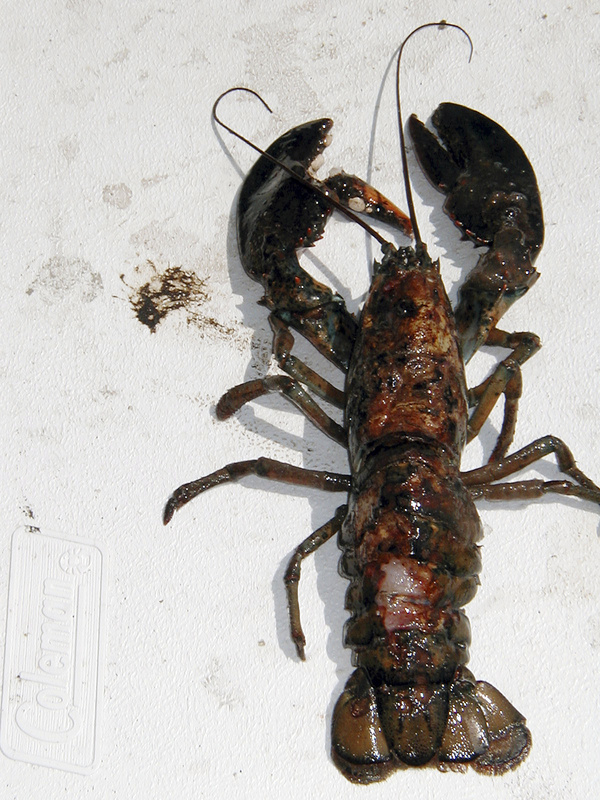PORTLAND – A shell disease that has plagued the southern New England lobster industry for years by making lobsters unsightly and in some cases unmarketable appears to be creeping northward to the lobster-rich grounds off the coast of Maine.
The number of lobsters suffering from shell disease remains tiny in Maine — only three out of every 1,000 lobsters sampled last year had the disease. But scientists and lobstermen are concerned because the prevalence grew fivefold from 2010 to 2012.
The disease, which is not harmful to humans, first became noticeable in southern New England waters in the 1990s. About one in every three or four lobsters caught in waters off southern Massachusetts and Rhode Island in recent years has been diseased.
Carl Wilson, the state lobster biologist with the Department of Marine Resources, said people should be concerned — but not alarmed — by the numbers. People who look only at the percentage increase could get spooked and say, “Oh, my God, that’s a huge increase,” he said.
“But it’s not, considering all the sampling we have and all the caveats of our sampling design,” Wilson said. “But it’s something we are watching.”
Lobster is one of the most important fisheries in Maine and New England, valued at more than $400 million to fishermen and hundreds of millions more to coastal communities.
The fishery in southern New England waters has already been hurt by the so-called epizootic shell disease, which is caused by bacteria that eat away at a lobster’s shell, leaving behind ugly lesions. Diseased lobsters can still be processed but are unmarketable in the more valuable live market. The disease stresses lobsters and can sometimes kill them but doesn’t taint their meat.
When biologists first began sampling for the disease in Rhode Island, the prevalence was small: less than 1 percent in 1996 and 4 percent in 1997. But in 1998, the percentage jumped to nearly 20 percent; since then, it’s ranged from 18 to 34 percent a year.
A similar story has played out in Massachusetts south of Cape Cod, where an average of 22 percent of sampled lobsters have been diseased from 2000 to 2011. The rate peaked at 38 percent in 2011.
Shell disease could be linked to a number of pressures such as rising water temperatures, pollution and low oxygen levels in the water, said Kathy Castro, a fisheries biologist at the University of Rhode Island Fisheries Center. Young lobsters can molt out of the disease when they shed their shells and grow new ones; egg-bearing females have the highest prevalence because they don’t molt while they’re carrying eggs. Lobsters can die when the infection gets particularly bad and prevents them from properly molting.
Shell disease is much less prevalent in the colder waters of the Gulf of Maine, which stretches from Cape Cod to Nova Scotia, than it is in southern New England. But it’s still around.
In Massachusetts waters north of Cape Cod, about 3 percent of sampled lobsters have had the disease since 2000, with no upward trend.
Tracy Pugh, a fisheries biologist with the Massachusetts Division of Marine Fisheries, isn’t overly concerned about the Gulf of Maine lobster stock because the waters are cold.
“It’s certainly something to keep an eye on. But in terms of our perspective of Gulf of Maine shell disease, we don’t see it as something to get particularly concerned about,” she said. “The rates are pretty low. We don’t see a pattern.”
From 2008 to 2010, observers found about one diseased lobster for every 2,000 sampled in Maine. In 2011, that rate rose to four diseased lobsters in 2,000, and in 2012, it rose to six.
It’s not a large number, but it’s high enough to get lobstermen’s attention.
“From talking to fishermen from Massachusetts on up, it seems like each year it’s moving its way north a little bit,” said South Bristol lobsterman Arnold Gamage Jr., who’s been fishing all his life.
Still, he tries to keep it in perspective.
“If we go all day long and I see a few that have shell disease, I think to myself, ‘That’s a lot,'” Gamage said. “And I suppose it is a lot compared to none. But it’s still a very small number; it’s way less than 1 percent.”
Given the sudden increase in shell disease over a short period in southern New England, Maine’s lobstermen, scientists and regulators have good reason to be worried, said Jeffrey Shields, a marine science professor at the Virginia Institute of Marine Science.
His advice: “Keep an eye on it. Keep monitoring it. Lobby federal and state agencies to fund research to understand more about it.”
Send questions/comments to the editors.



Success. Please wait for the page to reload. If the page does not reload within 5 seconds, please refresh the page.
Enter your email and password to access comments.
Hi, to comment on stories you must . This profile is in addition to your subscription and website login.
Already have a commenting profile? .
Invalid username/password.
Please check your email to confirm and complete your registration.
Only subscribers are eligible to post comments. Please subscribe or login first for digital access. Here’s why.
Use the form below to reset your password. When you've submitted your account email, we will send an email with a reset code.